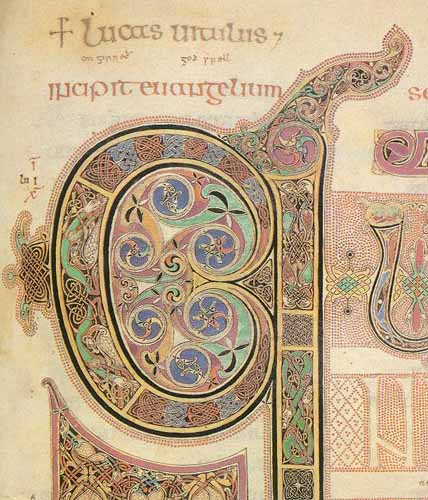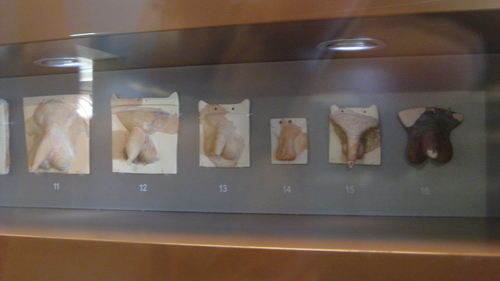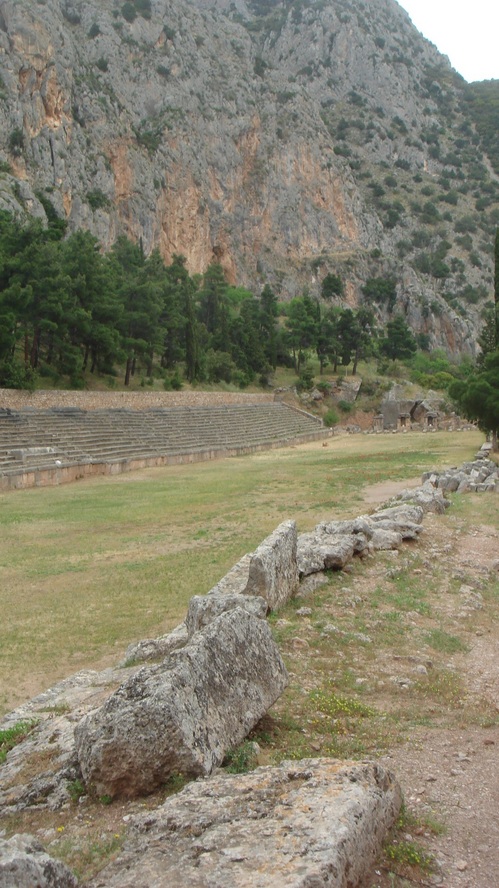CHAPTER THIRTY SIX: RISING TO THE OCCASION
Early on the first day of the week, while it was still dark, Miryam of Migdal, accompanied by several other Galilean women, went to the tomb of Jesus and saw that the stone had been removed from the entrance. She came running all the way down the Hinnom valley to the path that led to Bethany to Eliezer’s house to alert Simon and the one Jesus loved, the leaders of the Galilean and Judean disciples respectively, and said, “They have taken the Lord out of the tomb, and we don’t know where they have put him!”
So Simon and Eliezer started for the tomb. Both were running, but Eliezer out ran Simon and reached the tomb first, not least because he knew exactly where Joseph had buried him. He bent over and looked in at the strips of linen lying there in the tomb but did not go in. Then Simon, who was behind him, arrived, all out of breath, and without hesitating went straight into the tomb. He also saw the strips of linen lying there, as well as the burial cloth that had been around Jesus’ head. The cloth was folded up by itself, separate from the linen. Thereafter, Eliezer who had reached the tomb first, also went inside. He saw and believed God had done something remarkable, perhaps even take Jesus directly up into heaven, which Jesus had seemed to speak about at the evening meals at his house earlier that week. But still even Eliezer did not understand from Scripture that Jesus had to rise from the dead.
Then Simon and Eliezer went back to Bethany to tell the other disciples and Jesus’ mother, but Miryam, overcome with grief remained outside the tomb with two of her fellow female disciples, crying. As she wept, she bent over to look into the tomb and saw two angels in white, seated where Jesus’ body had been, one at the head and the other at the foot.
They asked her, “Woman, why are you crying?”
“They have taken my Lord away,” she said, “and we don’t know where they have put him.”
The two angels in clothes that gleamed like lightning stood beside Miryam and her companions. In their fright the women bowed down with their faces to the ground, but the angels said to them, “Why do you look for the living among the dead? He is not here; he has risen! Remember how he told you, while he was still with you in Galilee: ‘The Son of Man must be delivered into the hands of sinful men, be crucified and on the third day be raised again.’ ” Then they remembered his words, but when they looked up the angels disappeared.
At this, Miryam turned around and saw Jesus standing there, but she did not realize that it was Jesus.
“Woman,” he said, “why are you crying? Who is it you are looking for?”
Thinking he was the gardener, she said, “Sir, if you have carried him away, tell me where you have put him, and I will get him.”
Jesus said to her, “Miryam!.” Recognizing his voice, she turned toward him and cried out in Aramaic, “Rabboni!” (which means Teacher) and she ran and clung to his cloak kneeling before him.
Jesus said, “Do not hold on to me, for I have not yet returned to the Father. Go instead to my brothers and tell them, ‘I am returning to my Father and your Father, to my God and your God.’ ” So it was that it was Miryam, the first of Jesus’ female disciples who was first to proclaim the good news about the risen Jesus. Commissioned by Jesus himself, she, with the other women, went to the male disciples with the news: “I have seen the Lord!” And Miryam told them that he had said these things to her. Unfortunately, these male disciples did not really believe her testimony or that of the other women, and indeed one had even suggested it was a woman’s fantasy or delirium from grief, so the women went to tell some of the other Judean disciples about this, hoping they would listen.
Later that same day two of Jesus’ Judean disciples were headed out of town to a village called Emmaus, about seven miles from Jerusalem. They were talking with each other about everything that had happened. As they talked and discussed these things with each other, Jesus himself came up and walked along with them; but they were kept from recognizing him.
He asked them, “What are you discussing together as you walk along?”
They stood still, their faces downcast. One of them, named Cleopas, asked him, “Are you only a visitor to Jerusalem and do not know the things that have happened there in these days?”
“What things?” he asked.
“About Jesus of Netzerit,” they replied. “He was a prophet, powerful in word and deed before God and all the people. The chief priests and our rulers handed him over to be sentenced to death, and they crucified him; but we had hoped that he was the one who was going to redeem Israel. And what is more, it is the third day since all this took place. In addition, some of our women amazed us. They went to the tomb early this morning but didn’t find his body. They came and told us that they had seen a vision of angels, who said he was alive and they claimed to have seen him as well. Then some of our com-panions went to the tomb and found it just as the women had said, but him they did not see.”
He said to them, “How foolish you are, and how slow of heart to believe all that the prophets have spoken! Did not the messiah have to suffer these things and then enter his glory?” And beginning with Moses and all the Prophets, he explained to them what was said in all the Scriptures concerning himself. As they approached the village to which they were going, Jesus acted as if he were going farther. But they urged him strongly, “Stay with us, for it is nearly evening; the day is almost over.” So he went in to stay with them.
When he was at the table with them, he took bread, gave thanks, broke it and began to give it to them. This stirred in their hearts the memories of some of the meals they had partaken of with Jesus that week, and so their eyes were opened and they recognized him, and at once he disappeared from their sight. They asked each other, “Were not our hearts burning within us while he talked with us on the road and opened the Scriptures to us?” They got up and returned at once to Jerusalem. There they found the Eleven and those with them, assembled together and saying, “It is true! The Lord has risen and has appeared to Simon and others!” Then the two told what had happened on the way, and how Jesus was recognized by them when he broke the bread.
It was not until the evening of that first day of the week, when the disciples were together at Eliezer’s, with the doors locked for fear of the Jewish authorities since they all knew where Eliezer lived, that Jesus came and stood among them and said, “Peace be with you!” After he said this, he showed them his hands and side. The disciples were ecstatic when they saw the Lord and most of them broke down and cried for joy.
Again Jesus said, “Peace be with you! As the Father has sent me, I am sending you.” And with that he breathed on them and said, “Receive the Holy Spirit. If you forgive anyone his sins, they are forgiven; if you do not forgive them, they are not forgiven.” But with this Jesus disappeared as quickly as he had appeared, leaving the disciples once more in shock at what had just happened. Now Thomas (called Didymus), one of the Twelve, was not with the disciples when Jesus came. So the other disciples told him, “We have seen the Lord!” But he said to them, “Unless I see the nail marks in his hands and put my finger where the nails were, and put my hand into his side, I will not believe it.” And several days went by and still Jesus had not appeared so Thomas was becoming more and more skeptical and lacking in faith.
It was in fact a week later and his disciples were in the same house again, and this time Thomas was with them. Though the doors were locked, Jesus came and stood among them and said, “Peace be with you!” Then he said to Thomas, “Put your finger here; see my hands. Reach out your hand and put it into my side. Stop doubting and believe.” Thomas fell down before Jesus and said to him with tears in his eyes, “My Lord and my God!”
Then Jesus told him, “Because you have seen me, you have believed; blessed are those who have not seen and yet have believed.” But once again Jesus disappeared from their midst. When several more days went by, Simon remembered that Jesus had said before his death that he would go before them into Galilee and meet them there. “Let’s head north to Galilee, and spend a little time fishing, reflecting on all that has happened. Our Master said he would meet us there, and I trust he will.”
This sounded like a good plan to the other disciples not least because the authorities had gotten word that Jesus’ body was missing from the grave, and so Eliezer said, “I’m coming with you. I would like to see the Galilee and hear more about your work with Jesus in that region.” Jesus’ mother however had decided she would stay in Jerusalem for some time with her sister and friends like Miryam and Martha, so she did not return to Galilee on this occasion.
The roads were full of pilgrims returning up to Galilee by the great north south road, and the Galilean disciples were glad to be going home, away from the tense and intense environment in Jerusalem. The very first morning after they had gotten back to Kefer-Nahum Simon, Thomas, Nathan’el from Cana in Galilee, the sons of Zebedee, and two Judean disciples, one of whom was Eliezer, decided to go fishing, leaving in the dark long before the sun dawned over the lake.
“I’m going out to fish,” Simon told them, and they said, “We’ll go with you.” So they went out and got into the boat, but that night they caught nothing. Early in the morning, Jesus stood on the shore, but the disciples did not realize that it was Jesus.
He called out to them, “Friends, haven’t you any fish?”
“No,” they answered.
He said, “Throw your net on the right side of the boat and you will find some.” When they did, they were unable to haul the net in because of the large number of fish. Then the disciple whom Jesus loved said to Simon, “It is the Master” for he remembered the story about the first time Jesus had gotten into a boat with Simon and what happened then. As soon as Simon heard him say, “It is the Master,” he wrapped his outer garment around him (for he had taken it off) and jumped into the water. The other disciples followed in the boat, towing the net full of fish, for they were not far from shore, about a hundred yards. When they landed, they saw a fire of burning coals there with fish on it, and some bread. It reminded Simon of the charcoal fire he had warmed his hands on in the courtyard of Caiaphas.
Jesus said to them, “Bring some of the fish you have just caught.”
Simon climbed aboard and dragged the net ashore. It was full of large fish, 153, but even with so many the net was not torn. Jesus said to them, “Come and have breakfast.” Jesus took the bread and gave it to them, and did the same with the fish. This was now the third time Jesus appeared to his male disciples as a group, after he was raised from the dead. Jesus said to all the disciples gathered on that morning, “I am sending you out now to spread the good news about me, and so you must go, baptizing people in G-d’s name and making disciples, bearing in mind that I will be with you all along through the presence of G-d’s Spirit, whom I will send to you when I return to the Father.”
When they had finished eating, Jesus said to Simon in particular, “Simon son of John, do you love me more than these?”
“Yes, Master,” he said, “you know that I love you.”
Jesus said, “Feed my lambs.”
Again Jesus said, “Simon son of John, do you truly love me?”
He answered, “Yes, Lord, you know that I love you.”
Jesus said, “Take care of my sheep.”
The third time he said to him, “Simon son of John, do you love me?”
Simon was hurt because Jesus asked him the third time, “Do you love me?” He began to weep and as the tears rolled down his face he whispered in a voice filled with remorse, “Master, you know all things; you know that I love you.”
Jesus said, “Then feed my sheep. Amen, amen I say to you, when you were younger you dressed yourself and went where you wanted; but when you are old you will stretch out your hands, and someone else will dress you and lead you where you do not want to go.” Jesus said this to indicate the kind of death by which Simon would glorify God. Then he said to him, “Follow me!” Simon turned and saw that the disciple whom Jesus loved was following them. When Simon saw Eliezer, he asked, “Master, what about him?”
Jesus answered, “If I want him to remain alive until I return, what is that to you? You must follow me.” Because of this, the rumor spread among the brothers that this disciple would not die, not least because Jesus had already raised him from death once. But Jesus did not say that he would not die; he only said, “If I want him to remain alive until I return, what is that to you?” This is the disciple who testified to many of these things because he had seen them with his own eyes and then wrote them down.
Jesus did many other things as well. If every one of them were written down, I suppose that even the whole world would not have room for the books that would be written. But these things have been written so that you might begin to believe that Jesus, the divine and human Son of Man, was also the Son of the living G-d, the messiah of the Jews, and the Savior of the world.
THE END


